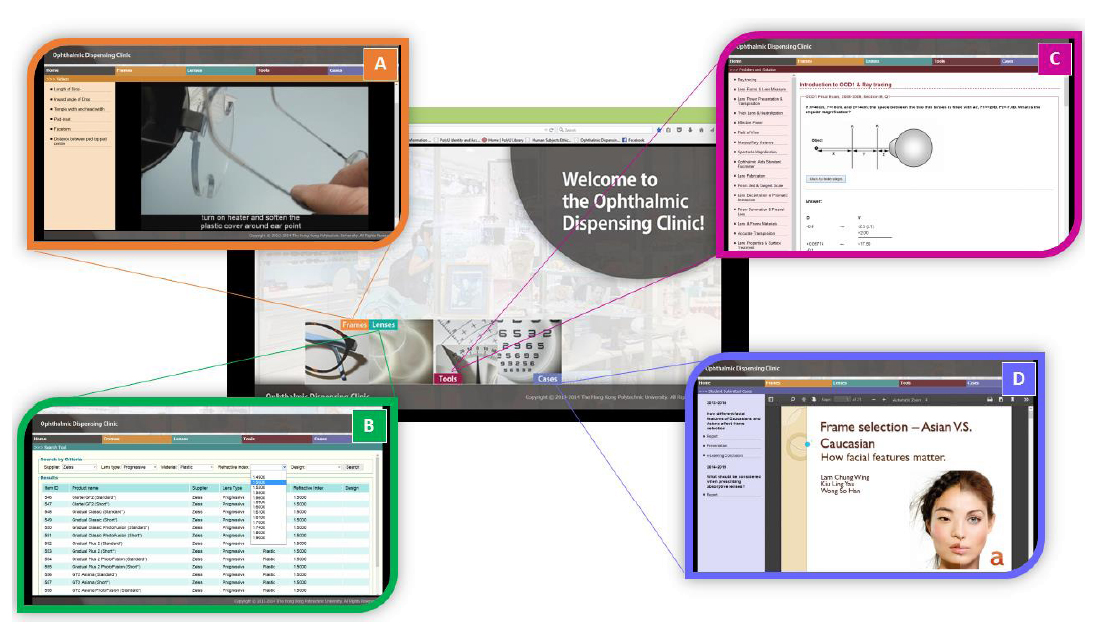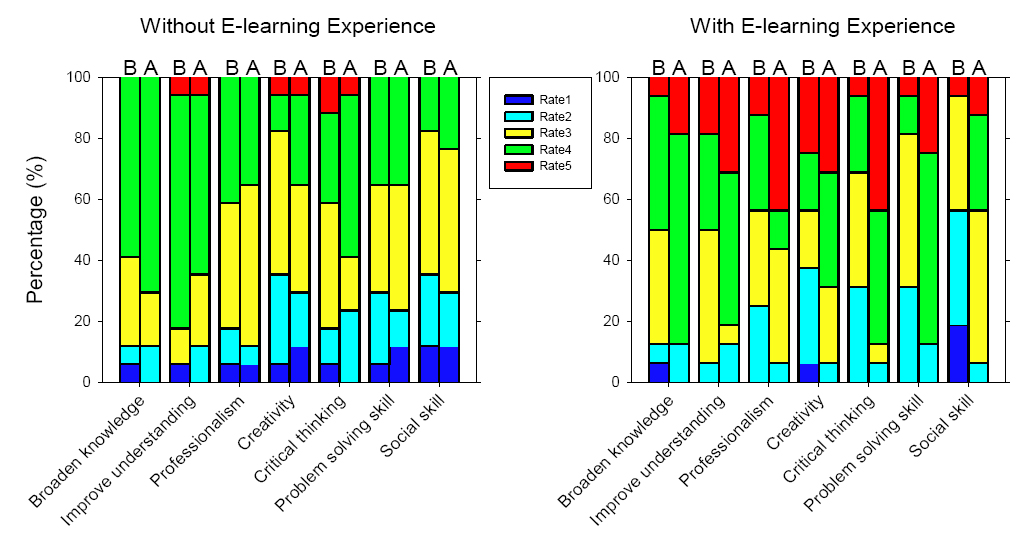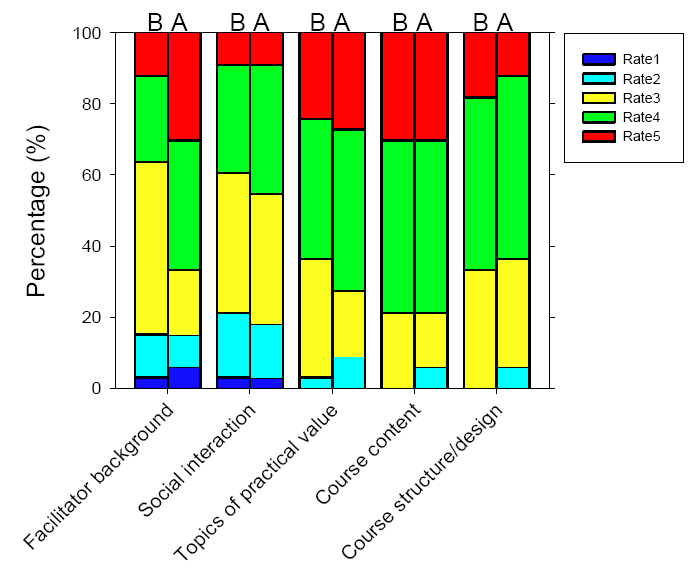
|
![]() : A Virtual Ophthalmic Dispensing Clinic: Developing a Teaching Interface for Problem-base Learning
: A Virtual Ophthalmic Dispensing Clinic: Developing a Teaching Interface for Problem-base Learning
Description
An online Ophthalmic Dispensing Virtual Clinic (ODVC) was designed to facilitate the implementation of a case-based learning approach in the optometry subjects Ophthalmic Optics and Dispensing I & II. This virtual clinic, an online interface designed to be used by three groups of participants: students, supervising optometrists and subject leaders, aimed to serve two important functions: (1) provide easy access to most updated ophthalmic optics resources in Hong Kong; and (2) solve case-based ophthalmic dispensing problems through student-supervisor interaction usinig an online discussion forum. The key components of ODVC that facilitate the online discussion forum are illustrated in Figure 1 and described below:
- (A) Frame adjustment: A series of high-resolution video clips was prepared to demonstrate the appropriate adjustment methods for different frame parameters.
- (B) Lens search: A search tool was designed to provide an easy access to lens product information collected from four major local ophthalmic lens suppliers. This information includes key optical properties, dispensing parameters, and suggested retailed price, providing a good coverage of market information for students.
- (C) Problem & solution: Calculations related to ophthalmic optics and dispensing were demonstrated for past year questions.
- (D) Case bank: This bank deposited representative solutions created by students for realistic ophthalmic dispensing problems, providing exemplary reference for junior year students.

Figure 1: Key teaching resources developed in ODVC online platform: A) frame adjustment high-resolution video clips; B) lens search tool; D) problem and solution of ophthalmic optics; and D) case bank demonstrating the works of representative student’s project.
Evaluation
To evaluate the usefulness of ODVC, two cohorts of students, one taking OOD1 and the other taking OOD2, were asked to participate in both of the questioinnaires before and after the semester. The questionnaires were designed to understand how online resource may help to facilitate the student's learning experience through an e-learning course.
Results of the Questionnaires
For OOD1:
Q1: What resources were used by students to prepare an exam paper involving calculation?
Of the 34 participants, all used more than one resources to prepare for an exam paper involving calculation, the most popular media were: lecture note (91.2%), exercise prepared by lecturer (85.3%) and past year exam papers (79.4%); the least used media was textbook example (32.4%). The methods were similar when preparing for the ophthalmic optics exam: lecture note (100%), exercise prepared by lecturer (82.4%), past year exam papers (52.9%) and textbook example (35.3%). The majority thought that the exercise provided by lecturer (91.2%), the lecture notes (88.2%) and past year exam papers (76.5%) provided enough coverage for their exam preparation; however, only 38.2% participants thought that textbook example provided enough coverage. Before introducing the ODVC to our students, nearly one-third (32.4%) of the participants did not expect that an online resource would be helpful for their preparation of ophthalmic optics exam.
Q2: How useful were “lens search”, “problem & solution”, and ODVC as a whole?
Of the 35 participants who had used ODVC over the semester, more than twothird of them (68.6%-100%) rated either “4” or “5” for all the learning components designed for “lens search” and “problem & solution”. In general, 91.4% of the participants agreed that ODVC was helpful in learning OOD1, a significant change from their expectation before ODVC was introduced (32.4%, see above).
For OOD2:
Q1: How learning outcomes contribute to an e-learning course?
- Regardless of whether the students had previous experience of e-learning, the majority of participants (≥50%) expected an E-learning course should both broaden their knowledge beyond the lectures and improve their understanding of course content (Figure 2).
- In 17 participants who had no previous experience of e-learning, introducing ODVC improved their ratings (i.e., rated “4” or “5”) on learning outcomes including “broaden knowledge”, “creativity”, “critical thinking”, and “social skill” (Figure 2).
- In 16 participants who had previous experience of E-learning, introducing ODVC over the semester improved all learning outcomes tested (Figure 2).

Figure 2: Students’ evaluation of individual teaching components of ODVC in students without (left panel) and with (right panel) previous experience of E-learning class. For each teaching component, feedbacks were collected before (“B”, left) and after (“A”, right) introducing ODVC to the class.
Q2: What other factors could facilitate E-learning experience?
Of the 33 participants, more than half consistently looked for “Course content”, “course structure/design”, and “topics of practical value” offered by e-learning class. After the students used the ODVC for a semester, more students (i.e., rated “4” or “5”) thought that “facilitator background” and “social interaction” may facilitate their e-learning experience (Figure 3).

Figure 3: Students’ evaluation of additional components that may facilitate their learning experience of E-learning class. For each teaching component, feedbacks were collected before (“B”, left) and after (“A”, right) introducing ODVC to the class.
Conclusion
The introduction of ODVC into the OOD1 and OOD2 has facilitated student’s learning experience in integrating knowledge in class and outside class. From the results of students’ feedback questionnaire, the E-learning components available on ODVC seem to fulfill their expectations in multiple learning outcomes. Future challenges include a constant update of market information, providing a greater coverage of different ophthalmic optics topics, and improving the contents by incorporating suggestions from experts in the field.
Disclaimer
The experiences reported in this section are collected from the project leaders. EDC is not liable for the accuracy of information and possible infringements of copyright associated with individual cases.